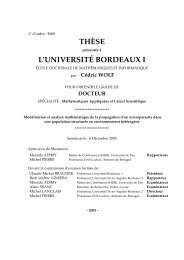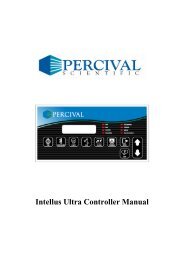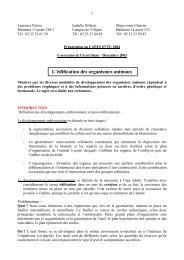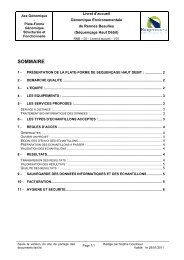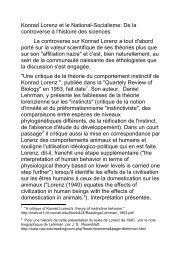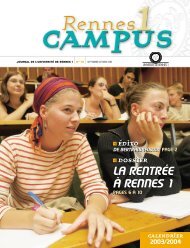1 CHIRONOMUS NEWSLETTER ON CHIRONOMIDAE RESEARCH ...
1 CHIRONOMUS NEWSLETTER ON CHIRONOMIDAE RESEARCH ...
1 CHIRONOMUS NEWSLETTER ON CHIRONOMIDAE RESEARCH ...
Create successful ePaper yourself
Turn your PDF publications into a flip-book with our unique Google optimized e-Paper software.
In the temperate highlands, species of<br />
Polypedilum, Parachironomus, as well as<br />
orthocladiids (Limnophyes, Orthocladius etc.)<br />
dominated the community (24 sp./msp.).<br />
Likewise to the above, deformity frequencies<br />
varied between 2.0 and 8 percent.<br />
The results nearly force the conclusion that the<br />
frequency of buccal deformities in chironomid<br />
larvae cannot be explained by a simple<br />
correlation with heavy metal concentrations in<br />
the studied area. As a first approach, two<br />
reasons for this can be assumed: Firstly, heavy<br />
metals represent only one of the possible<br />
stressors which may induce deformities<br />
(NAZAROVA et al. 2001, VERMEULEN 1995,<br />
WARWICK 1988). Actually there are no data<br />
about other agents in the region, and far less do<br />
we know about the role of synergisms on a<br />
small spatial scale (e.g. the coincidence with<br />
oxygen depletion, sediment particle structure<br />
etc.). After all, organic contamination and thus<br />
high heterotrophic activity, is a crucial factor<br />
that determines the structure of the benthic<br />
community in streams and rivers of the<br />
investigated region (RISS et al. in press).<br />
Secondly, the study itself covers a large spatial<br />
scale which stretches over distinct climatic and<br />
biogeographic zones. And above all,<br />
environmental conditions between the extreme<br />
sites are hardly comparable due to the<br />
temperature gradient of 18°C on the annual<br />
average.<br />
In spite of these restrictions, bioindicative<br />
assessments like the present one, continue to<br />
be of great interest for national environmental<br />
agencies and so may provide a certain financial<br />
basis for more specific work. Regarding this<br />
topic, the focus of interest should aim more on<br />
synergistic processes in the microhabitat, and<br />
be restricted to one biogeographic region, as<br />
was mentioned above. Even if political<br />
conditions in the country complicate the<br />
realization of such projects, a descriptive<br />
33<br />
approach provides a small, but valuable insight<br />
into ecological and physiological processes<br />
and by this a useful didactic tool for scientific<br />
education.<br />
This work was presented on the 'International<br />
South American Congress of Limnology -<br />
Neolimnos 2002' in Leticia/Colombia with<br />
financial support of the DFG.<br />
Bibliography<br />
NAZAROVA, L.B., H.W. RISS & A. KAHLHEBER:<br />
Some observations of buccal deformities in<br />
chironomid larvae Diptera: Chironomidae) from<br />
the Ciénaga Grande de Santa Marta, Colombia. -<br />
Caldasia (in press).<br />
NAZAROVA L.B., L.K. GOVORKOVA, R.M. SABIROV<br />
& Z.V. LATYPOVA 2001. Morphological<br />
deformations of chironomid larvae in assessment<br />
of Kuybishev water reservoir ecological state. -<br />
Environ. Radioecol. App. Ecol. 7 (2) 22-27.<br />
PERDOMO, L., I. ENSMINGER, L.F. ESPINOSA, C.<br />
ELSTER, M. WALLNER-KERSANACH & M.L.<br />
SCHNETTER 1998. The mangrove ecosystem of<br />
the Ciénaga Grande de Santa Marta Colombia.<br />
Observations on regeneration and trace metals in<br />
sediment. - Mar. Poll. Bull. 37 (8-12) 393-403.<br />
RISS, H.W., R. OSPINA & J.D. GUTIÉRREZ.<br />
Establecimiento de valores de bioindicación para<br />
macroinvertebrados acuáticos de la sabana de<br />
Bogota. - Caldasia (in press).<br />
STEGGER, P., H.W. RISS, E. BLÜBAUM-GR<strong>ON</strong>AU &<br />
E.I. MEYER 2002. Mentum- und<br />
Mandibeldeformationen bei Chironomus-Larven<br />
(Diptera: Chironomidae) als Testkriterium für<br />
Sedimentkontaktteste: Ein kritischer Beitrag. -<br />
Deutsche Gesellschaft für Limnologie (DGL) -<br />
Tagungsbericht 2001 (Kiel), Tutzing 2002: 819-<br />
824.<br />
VERMEULEN A.C. 1995. Elaboration chironomid<br />
deformities as bioindicators of toxic sediment<br />
stress: the potential application of mixture<br />
toxicity concepts. - Ann. Zool. Fenn. 32: 265-<br />
285.<br />
WARWICK W.F. 1988. Morphological deformities<br />
in Chironomidae (Diptera) larvae as biological<br />
indicators of toxic stress. Toxic contaminants<br />
and ecosystem health; A Great Lakes focus. John<br />
Wiley & Sons: 281-320.



